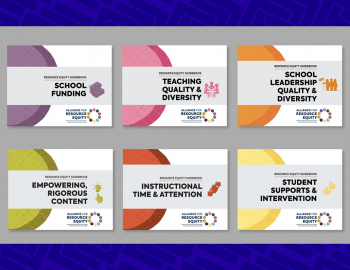- Home
- Resource Library
- Search Results
71 - 80 of 152
results for "district partnerships"
71 - 80 of 152
results for "district partnerships"
- Leader Preparation ×

Webinar
This webinar features Linda Darling-Hammond and a panel including an educator preparation dean and two district leaders.
![[Chart] Phase 1: Surfaced core beliefs and developed theory of action; Phase 3: Created a coherent program of study](/sites/default/files/styles/recent_resource_vertical_350x270/public/2022-12/jrle-lessons-learned.jpg?itok=0Q-k31qY)
Journal Article
Lessons Learned From Designing a Principal Preparation Program: Equity, Coherence, and Collaboration
This article examines the planning and initial stages of Western Kentucky University’s (WKU) efforts to redesign the curriculum in their principal…

Tool
This set of resources provides planning tools that build on their identified 10 dimensions of education resource equity and the Resource Equity Diagnostic…

Research Report
This report from the Alliance for Resource Quality and The Education Trust identifies and explores 10 dimensions for providing better, more equitable…

Learning Café
Feb 25 2022 | The University of Connecticut will host an interactive session that includes a presentation and small group discussion to share strategies…

Research Report
This report synthesizes research on how to support educators in developing those capacities both in preservice and in-service contexts.

Multimedia
This 13-minute audiocast and accompanying brief from the California Center for School Climate at WestEd shares how the Pajaro Valley Unified School…

Webinar
Teacher shortages have been a chronic problem for decades and have now been significantly exacerbated by the COVID-19 pandemic. The second annual Educator…

Policy Report
In the policy report from the Regional Education Laboratory at WestEd, resources for state education agency (SEA) staff are provided to build partnerships…

Event
November 11-14, 2021 | 9 AM - 6 PMThe University Council for Educational Administration (UCEA) convention will be held November 11-14, 2021 in Columbus,…
Back To Top